KISS AND DON’T TELL: TIMOR-LESTE IN THE VENICE BIENNALE
Maria Madeira is the artist representing Timor-Leste at the 60th International Venice Biennale. Timor-Leste’s inaugural pavilion coincides with the country’s 25th anniversary of independence. Commissioned by the Ministry of Youth, Sports, Arts and Culture, Democratic Republic of Timor-Leste and curated by Professor Natalie King OAM.
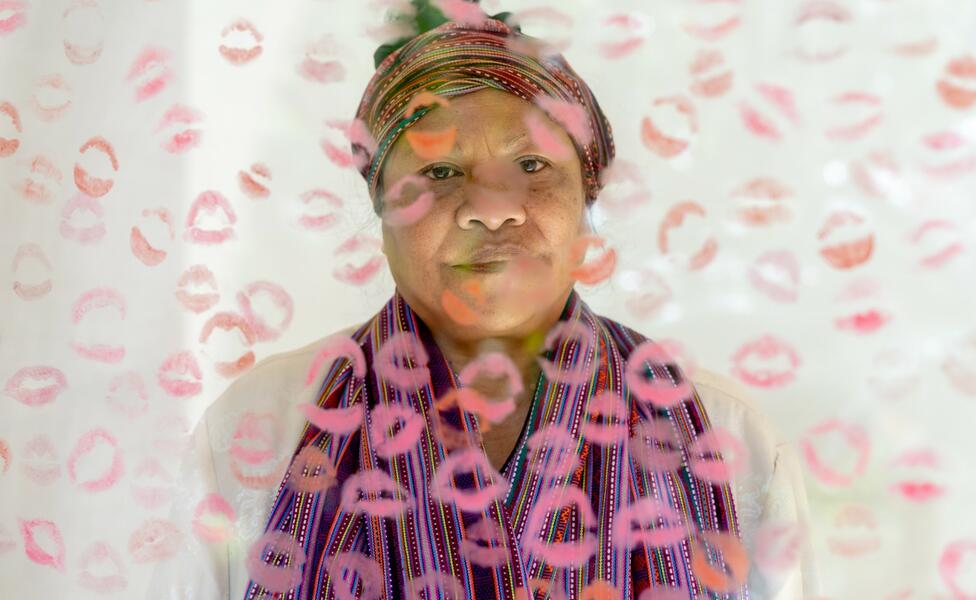
Madeira is one of Timor-Leste’s most significant contemporary visual artists working internationally, yet her practice is deeply embedded in local traditions, concerns and histories. For the Venice Biennale, Madeira presents Kiss and Don’t Tell, a new site-specific installation utilizing local materials such as tais (traditional textile), betelnut, earth and pigments. Her performative installation draws on the collective memories of her foremothers.
Responding to the Venice Biennale’s overarching theme Stranieri Ovunque—Foreigners Everywhere, curated by Adriano Pedrosa, Madeira imbues her work with her lived experience of displacement, having grown up in a refugee camp in Portugal with her mother. Kiss and Don’t Tell melds tenderness and trauma with the intimacy of a kiss. Madeira adeptly binds ancestral influences, traditional crafts with contemporary concerns for the plight of the voiceless.
During the opening days of the 60th Venice Biennale, Madeira kissed the walls with lipstick markings while singing traditional songs from her village in the Indigenous language Tetun. She sang a haunting Timorese song Ina Lou, literally meaning “Dear Mother Earth.” It is a spiritual mourning song known from the youngest generation to the oldest members of society with lyrics that refer to the cycle of birth and the journey of life and death.
An act of resistance, survival and resilience, Madeira’s cultural activism pays homage to the women of Timor-Leste and the suffering of women globally. She offers solace and a murmur of hope and healing.
-
Pavilion of TIMOR-LESTE. Kiss and Don't Tell. 60th International Art Exhibition - La Biennale di Venezia. Photo by: Andrea Avezzù. Courtesy: La Biennale di Venezia
-
Pavilion of TIMOR-LESTE. Kiss and Don't Tell. 60th International Art Exhibition - La Biennale di Venezia. Photo by: Andrea Avezzù. Courtesy: La Biennale di Venezia
-
Pavilion of TIMOR-LESTE. Kiss and Don't Tell. 60th International Art Exhibition - La Biennale di Venezia. Photo by: Andrea Avezzù. Courtesy: La Biennale di Venezia
-
Pavilion of TIMOR-LESTE. Kiss and Don't Tell. 60th International Art Exhibition - La Biennale di Venezia. Photo by: Andrea Avezzù. Courtesy: La Biennale di Venezia
-
Pavilion of TIMOR-LESTE. Kiss and Don't Tell. 60th International Art Exhibition - La Biennale di Venezia. Photo by: Andrea Avezzù. Courtesy: La Biennale di Venezia
-
Pavilion of TIMOR-LESTE. Kiss and Don't Tell. 60th International Art Exhibition - La Biennale di Venezia. Photo by: Andrea Avezzù. Courtesy: La Biennale di Venezia
-
Pavilion of TIMOR-LESTE. Kiss and Don't Tell. 60th International Art Exhibition - La Biennale di Venezia. Photo by: Andrea Avezzù. Courtesy: La Biennale di Venezia
-
Pavilion of TIMOR-LESTE. Kiss and Don't Tell. 60th International Art Exhibition - La Biennale di Venezia. Photo by: Andrea Avezzù. Courtesy: La Biennale di Venezia
-
Pavilion of TIMOR-LESTE. Kiss and Don't Tell. 60th International Art Exhibition - La Biennale di Venezia. Photo by: Andrea Avezzù. Courtesy: La Biennale di Venezia
Maria Madeira was born in the village of Geno in the Ermera region of Timor-Leste. The Portugese Air Force evacuated her from Timor in 1976 during the Indonesian invasion. She spent most of the following eight years in a refugee camp run by the Red Cross on the outskirts of Lisbon in Portugal and migrated with her family to Australia in August 1983.
Over the years, she obtained several academic qualifications. She graduated with a B.A. Fine Arts (Visual Arts) Degree from Curtin University, Perth in 1991. Two years later she received a Graduate Diploma of Education (Major in art) from the same university. In 1996, she obtained her second degree, a B.A. in Political Science from Murdoch University. In 2019, she completed a Doctor of Philosophy in Art from Curtin University, Australia.
Between 1996 and 2000, she worked in Western Australia as a high school art teacher, visual artist and cultural advisor for several arts and cultural organizations. Between 2000-2004, she returned to Timor-Leste to contribute to the recovery, rebuilding and redevelopment of Timor-Leste, the newest nation in Asia.
Related Topics
May interest you
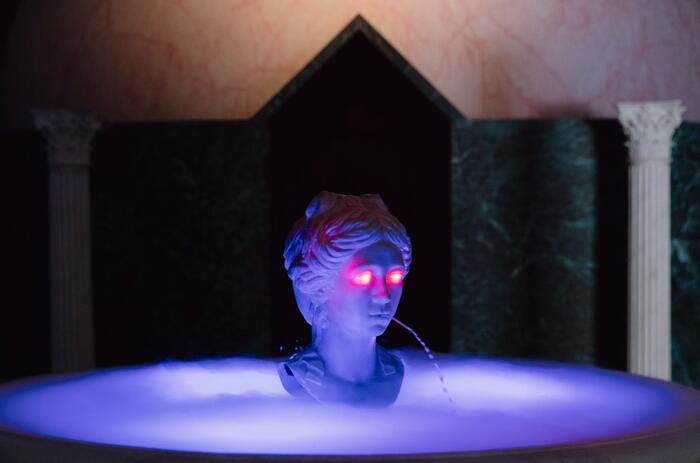
The Venice Bienanale’s Swiss Pavilion presents Super Superior Civilizations: an exhibition with the sixth and seventh chapters of Guerreiro do Divino Amor’s monumental “Superfictional World Atlas” saga: The Miracle of Helvetia and Roma Talismano. Curated by: Andrea Bellini.
THE SWISS PAVILION’S VENICE BIENNALE EXHIBITION BY GUERREIRO DO DIVINO AMOR
The Venice Bienanale’s Swiss Pavilion presents Super Superior Civilizations: an exhibition with the sixth and seventh chapters of Guerreiro do Divino Amor’s monumental “Superfictional World Atlas” saga: The Miracle of Helvetia and Roma Talismano. Curated by: Andrea Bellini.

The Venice Bienanale’s Swiss Pavilion presents Super Superior Civilizations: an exhibition with the sixth and seventh chapters of Guerreiro do Divino Amor’s monumental “Superfictional World Atlas” saga: The Miracle of Helvetia and Roma Talismano. Curated by: Andrea Bellini.
THE SWISS PAVILION’S VENICE BIENNALE EXHIBITION BY GUERREIRO DO DIVINO AMOR
The Venice Bienanale’s Swiss Pavilion presents Super Superior Civilizations: an exhibition with the sixth and seventh chapters of Guerreiro do Divino Amor’s monumental “Superfictional World Atlas” saga: The Miracle of Helvetia and Roma Talismano. Curated by: Andrea Bellini.
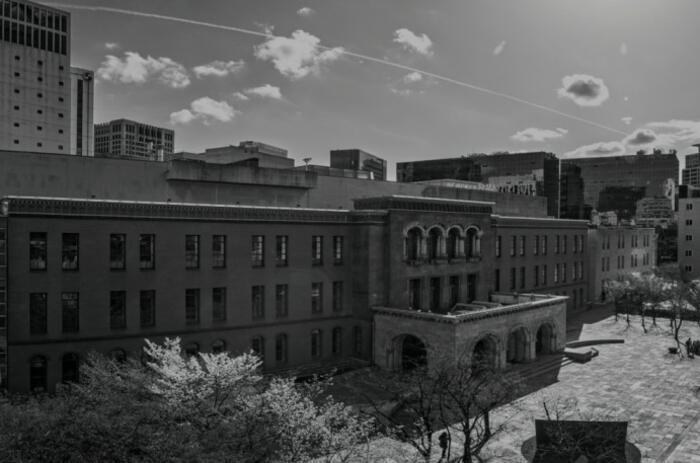
The Seoul Museum of Art is announcing an open call for the position of artistic director of the 13th Seoul Mediacity Biennale. Deadline to apply: July 28th, 2024.
13th SEOUL MEDIACITY BIENNALE CALLS FOR ARTISTIC DIRECTOR
The Seoul Museum of Art is announcing an open call for the position of artistic director of the 13th Seoul Mediacity Biennale. Deadline to apply: July 28th, 2024.

For the 60th Venice Biennale, the Republic of Armenia presents Echo, a multi-dimensional multi-media installation project by Paris-based Armenian artist Nina Khemchyan.
“ECHO” BY NINCA KHEMCHYAN: ARMENIAN PAVILION IN THE VENICE BIENNALE
For the 60th Venice Biennale, the Republic of Armenia presents Echo, a multi-dimensional multi-media installation project by Paris-based Armenian artist Nina Khemchyan.
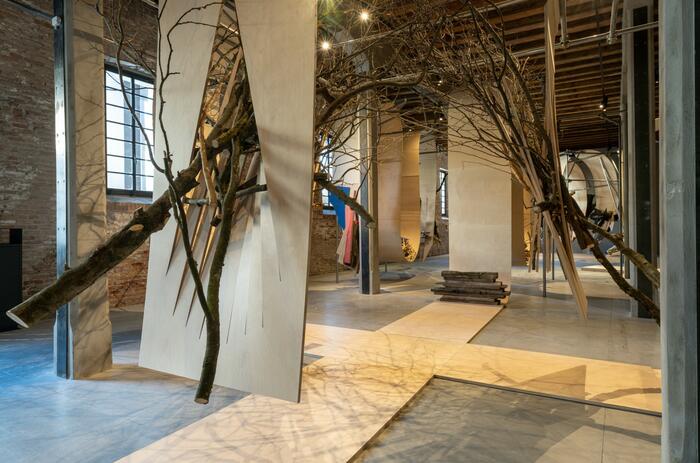
Ojalá se derrumben las puertas (Hopefully the Doors Will Fall Down) by artist Luciana Lamothe, curated by Sofía Dourron, is the installation presented by the Argentine Pavilion at the 60th International Art Exhibition of the Venice Biennale 2024.
THE ARGENTINE PAVILION IN THE VENICE BIENNALE
Ojalá se derrumben las puertas (Hopefully the Doors Will Fall Down) by artist Luciana Lamothe, curated by Sofía Dourron, is the installation presented by the Argentine Pavilion at the 60th International Art Exhibition of the Venice Biennale 2024.

The heart of a giraffe in captivity is twelve kilos lighter tells the story of Lenka the giraffe, drawing on the history of Czechoslovakia’s acquisition of animals from the Global South. Interpreted through contemporary ecological and decolonial perspectives, Eva Kotátková’s project of the Czech and Slovak Republic Pavilion at the Venice Biennale builds a space for imagining a different way of relating to nature.
THE VENICE BIENNALE: CZECH AND SLOVAK REPUBLIC PAVILION
The heart of a giraffe in captivity is twelve kilos lighter tells the story of Lenka the giraffe, drawing on the history of Czechoslovakia’s acquisition of animals from the Global South. Interpreted through contemporary ecological and decolonial perspectives, Eva Kotátková’s project of the Czech and Slovak Republic Pavilion at the Venice Biennale builds a space for imagining a different way of relating to nature.
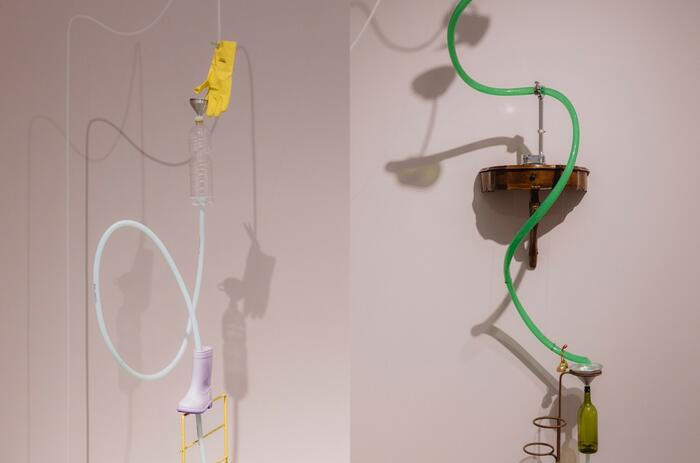
The Japan Foundation, the commissioner of the Japan Pavilion presents Compose, a solo exhibition created by Yuko Mohri and curated by Sook-Kyung Lee at the 60th International Venice Biennale.
COMPOSE: JAPAN PAVILION AT THE VENICE BIENNALE
The Japan Foundation, the commissioner of the Japan Pavilion presents Compose, a solo exhibition created by Yuko Mohri and curated by Sook-Kyung Lee at the 60th International Venice Biennale.
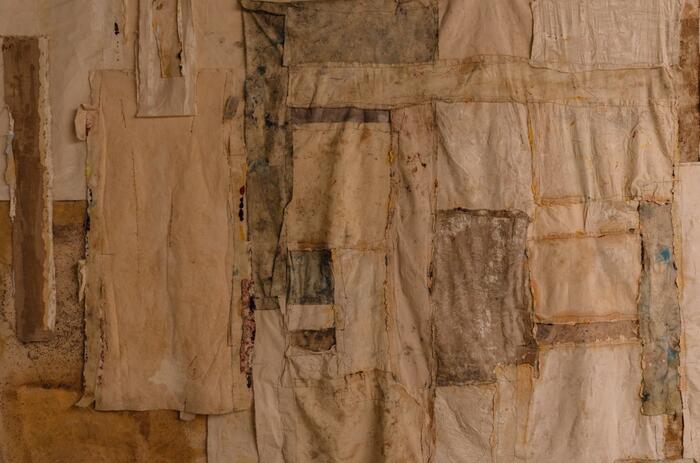
Commissioned by Facundo de Almeida and curated by Elisa Valerio, the national pavilion of Uruguay presents the work of Eduardo Cardozo with the project Latent.
THE PAVILION OF URUGUAY AT THE 60TH VENICE BIENNALE
Commissioned by Facundo de Almeida and curated by Elisa Valerio, the national pavilion of Uruguay presents the work of Eduardo Cardozo with the project Latent.
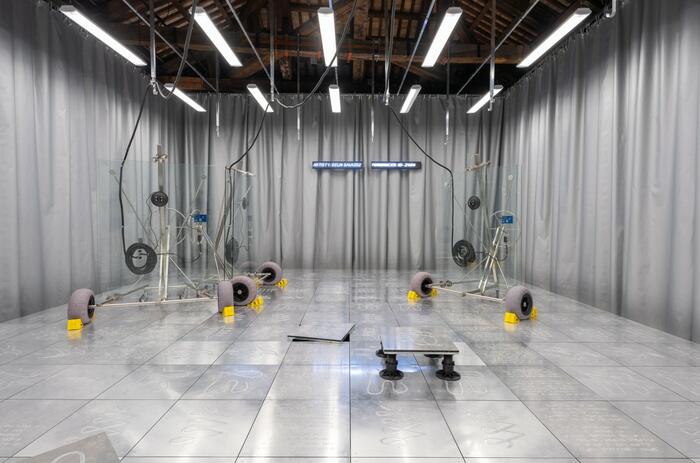
A Comparative Dialogue Act, a project by the Luxembourgish artist Andrea Mancini and the multidisciplinary collective Every Island is representing the Luxembourg Pavilion at the 60th Venice Biennale.
ANDREA MANCINI & EVERY ISLAND: LUXEMBOURG PAVILION AT THE VENICE BIENNALE
A Comparative Dialogue Act, a project by the Luxembourgish artist Andrea Mancini and the multidisciplinary collective Every Island is representing the Luxembourg Pavilion at the 60th Venice Biennale.

Malta’s pavilion at the 60th Venice Biennale presented artist Matthew Attard’s solo project, I Will Follow the Ship. Curated by Elyse Tonna and Sara Dolfi Agostini.
MALTA PAVILION AT THE VENICE BIENNALE 2024
Malta’s pavilion at the 60th Venice Biennale presented artist Matthew Attard’s solo project, I Will Follow the Ship. Curated by Elyse Tonna and Sara Dolfi Agostini.
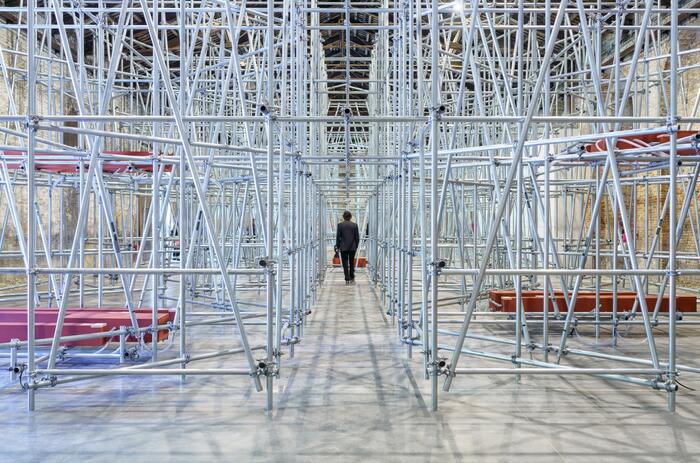
Due qui / To Hear is the project for the Italian Pavilion at the 60th Venice Biennale Curated by Luca Cerizza (with the assistance of Francesca Verga), it presents work that Massimo Bartolini has created in collaboration with several musicians (for the permanent installations) and writers (for the public program), employing the cooperative approach that is a hallmark of his practice.
DUE QUI/TO HEAR: ITALY’S PAVILION FOR THE VENICE BIENNALE
Due qui / To Hear is the project for the Italian Pavilion at the 60th Venice Biennale Curated by Luca Cerizza (with the assistance of Francesca Verga), it presents work that Massimo Bartolini has created in collaboration with several musicians (for the permanent installations) and writers (for the public program), employing the cooperative approach that is a hallmark of his practice.
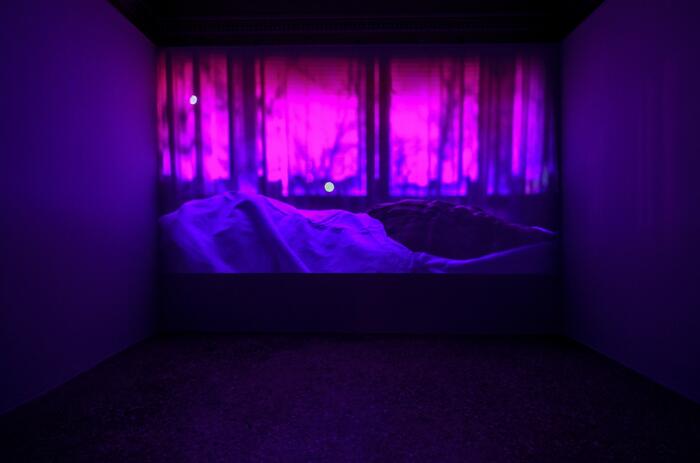
The Georgian Pavilion in the 60th Venice Biennale presented The Art of Seeing– States of Astronomy, a collaborative project presented by a team of Georgian and French curators and artists.
THE ART OF SEEING: GEORGIA’S PAVILION IN THE VENICE BIENNALE
The Georgian Pavilion in the 60th Venice Biennale presented The Art of Seeing– States of Astronomy, a collaborative project presented by a team of Georgian and French curators and artists.
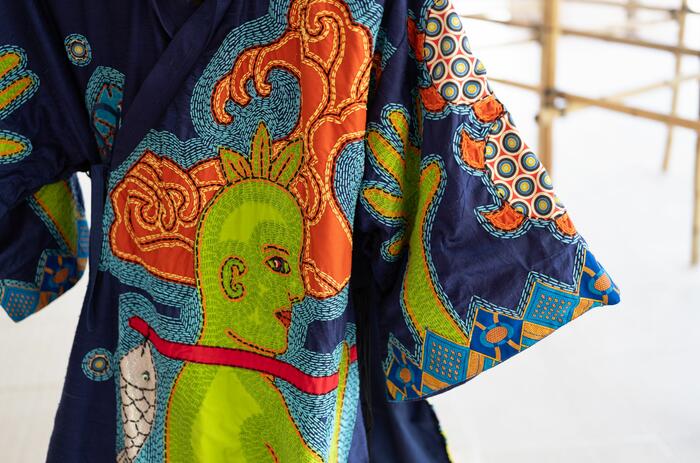
For the 60th International Art Exhibition – La Biennale di Venezia, the Nordic Countries Pavilion invites the audience to embark on a journey aboard a spectral dragon ship which occupies the light and open architecture of Sverre Fehn’s meditative masterpiece in the Giardini of the Biennale, Venice.
THE ALTERSEA OPERA: THE NORDIC COUNTRIES PAVILION'S PROPOSAL
For the 60th International Art Exhibition – La Biennale di Venezia, the Nordic Countries Pavilion invites the audience to embark on a journey aboard a spectral dragon ship which occupies the light and open architecture of Sverre Fehn’s meditative masterpiece in the Giardini of the Biennale, Venice.

The International Celebration of Blasphemy and The Sacred is a presentation by Congolese artist collective Cercle d’Art des Travailleurs de Plantation Congolaise (CATPC) for the Dutch Pavilion at the 60th Venice Biennale.
DUTCH PAVILION AT THE VENICE BIENNALE
The International Celebration of Blasphemy and The Sacred is a presentation by Congolese artist collective Cercle d’Art des Travailleurs de Plantation Congolaise (CATPC) for the Dutch Pavilion at the 60th Venice Biennale.
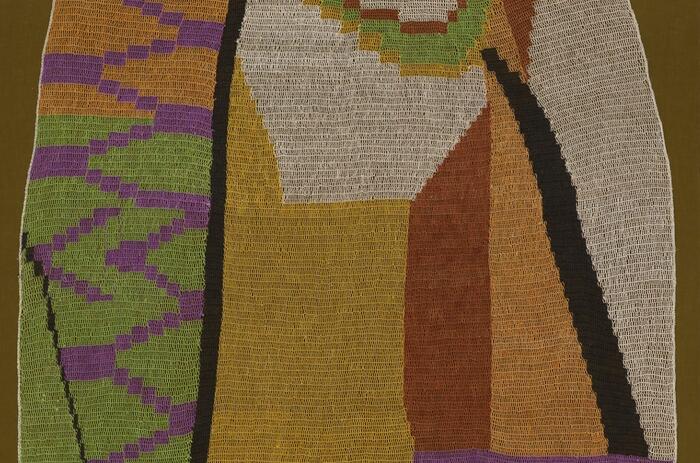
For the 60th International Exhibition of la Biennale di Venezia Stranieri Ovunque (Foregneirs Everywhere), artist Claudia Alarcón and art-collective Silät are presenting their reflections on being treated as foreigners in their own country.
CLAUDIA ALARCÓN AND SILÄT’S VENICE BIENNALE PARTICIPATION
For the 60th International Exhibition of la Biennale di Venezia Stranieri Ovunque (Foregneirs Everywhere), artist Claudia Alarcón and art-collective Silät are presenting their reflections on being treated as foreigners in their own country.
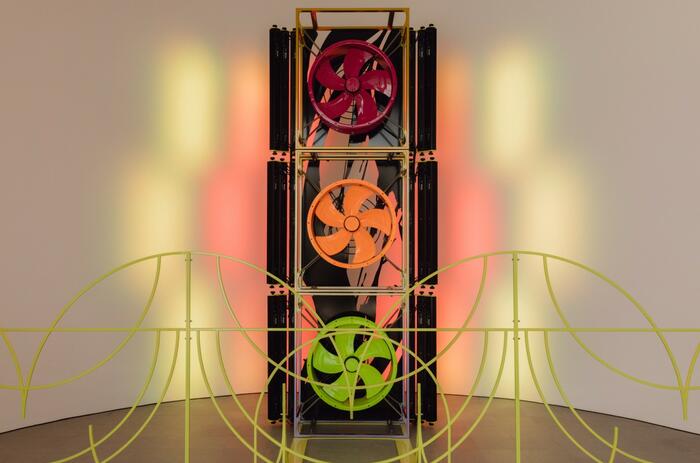
For the 60th International Venice Biennale, Nemes designed the project as an immersive, painting-based Gesamtkunstwerk that expands the genre of painting and extends it to other media. Project curated by Róna Kopeczky.
TECHNO ZEN BY MÁRTON NEMEZ: THE HUNGARIAN PAVILION IN VENICE BIENNALE
For the 60th International Venice Biennale, Nemes designed the project as an immersive, painting-based Gesamtkunstwerk that expands the genre of painting and extends it to other media. Project curated by Róna Kopeczky.
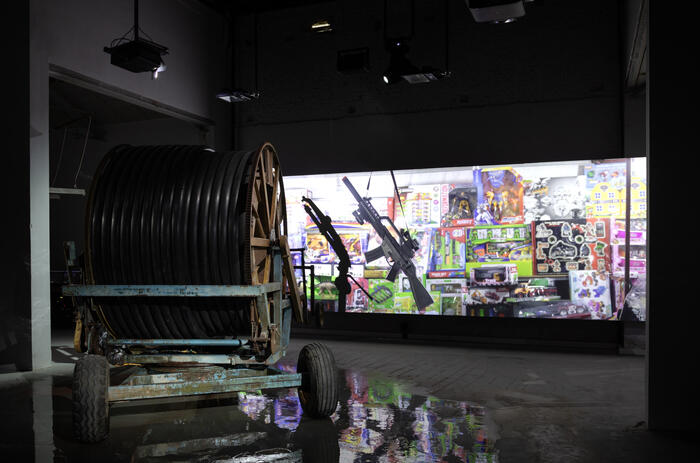
Xirómero / Dryland is an interdisciplinary collective work conceived by Thanasis Deligiannis and Yannis Michalopoulos, created along with the artists Elia Kalogianni, Yorgos Kyvernitis, Kostas Chaikalis and Fotis Sagonas for the Greek Pavilion at the 60th Venice Biennale. The project is curated by Panos Giannikopoulos.
WATER AS A PRISM: GREEK PAVILION AT THE VENICE BIENNALE
Xirómero / Dryland is an interdisciplinary collective work conceived by Thanasis Deligiannis and Yannis Michalopoulos, created along with the artists Elia Kalogianni, Yorgos Kyvernitis, Kostas Chaikalis and Fotis Sagonas for the Greek Pavilion at the 60th Venice Biennale. The project is curated by Panos Giannikopoulos.

The exhibition of the 60th edition of the Venice Biennale - Stranieri Ovunque (Foregneirs Everywhere) - curated by Brazilian Adriano Pedrosa, presents 331 artists, significantly more than the usual number. More than a third of those artists come from Latin America.
FOREIGNERS EVERYWHERE: LATIN AMERICA TAKES OVER THE VENICE BIENNALE
The exhibition of the 60th edition of the Venice Biennale - Stranieri Ovunque (Foregneirs Everywhere) - curated by Brazilian Adriano Pedrosa, presents 331 artists, significantly more than the usual number. More than a third of those artists come from Latin America.

The Kunsthalle Lissabon presents Quinze Anos de Amor na República dos Pangolins (Fifteen Years of Love at the Pangolin Republic), the third and last exhibition with which the institution celebrates its fifteenth anniversary. On this occasion, the center has invited curator Filipa Ramos, one of the Portuguese professionals with the most international projection, who has managed to put together a roster of artists with a strong Latin American presence, with Ad Minoliti, Amalia Pica, Daniel Gustav Cramer, Flora Rebollo, Gabriel Chaile, Haris Epaminonda, Irene Kopelman, Jonathas de Andrade, Luís Lázaro Matos, Mariana Caló and Francisco Queimadela, Mounira Al Solh, Nuno Sousa Vieira, Sheroanawe Hakihiiwe, Sol Calero, Teresa Solar Abboud and Wilfredo Prieto.
LATIN AMERICA AT THE XV ANNIVERSARY OF KUNSTHALLE LISSABON
The Kunsthalle Lissabon presents Quinze Anos de Amor na República dos Pangolins (Fifteen Years of Love at the Pangolin Republic), the third and last exhibition with which the institution celebrates its fifteenth anniversary. On this occasion, the center has invited curator Filipa Ramos, one of the Portuguese professionals with the most international projection, who has managed to put together a roster of artists with a strong Latin American presence, with Ad Minoliti, Amalia Pica, Daniel Gustav Cramer, Flora Rebollo, Gabriel Chaile, Haris Epaminonda, Irene Kopelman, Jonathas de Andrade, Luís Lázaro Matos, Mariana Caló and Francisco Queimadela, Mounira Al Solh, Nuno Sousa Vieira, Sheroanawe Hakihiiwe, Sol Calero, Teresa Solar Abboud and Wilfredo Prieto.

The Venice Bienanale’s Swiss Pavilion presents Super Superior Civilizations: an exhibition with the sixth and seventh chapters of Guerreiro do Divino Amor’s monumental “Superfictional World Atlas” saga: The Miracle of Helvetia and Roma Talismano. Curated by: Andrea Bellini.
THE SWISS PAVILION’S VENICE BIENNALE EXHIBITION BY GUERREIRO DO DIVINO AMOR
The Venice Bienanale’s Swiss Pavilion presents Super Superior Civilizations: an exhibition with the sixth and seventh chapters of Guerreiro do Divino Amor’s monumental “Superfictional World Atlas” saga: The Miracle of Helvetia and Roma Talismano. Curated by: Andrea Bellini.

The Seoul Museum of Art is announcing an open call for the position of artistic director of the 13th Seoul Mediacity Biennale. Deadline to apply: July 28th, 2024.
13th SEOUL MEDIACITY BIENNALE CALLS FOR ARTISTIC DIRECTOR
The Seoul Museum of Art is announcing an open call for the position of artistic director of the 13th Seoul Mediacity Biennale. Deadline to apply: July 28th, 2024.

For the 60th Venice Biennale, the Republic of Armenia presents Echo, a multi-dimensional multi-media installation project by Paris-based Armenian artist Nina Khemchyan.
“ECHO” BY NINCA KHEMCHYAN: ARMENIAN PAVILION IN THE VENICE BIENNALE
For the 60th Venice Biennale, the Republic of Armenia presents Echo, a multi-dimensional multi-media installation project by Paris-based Armenian artist Nina Khemchyan.

Ojalá se derrumben las puertas (Hopefully the Doors Will Fall Down) by artist Luciana Lamothe, curated by Sofía Dourron, is the installation presented by the Argentine Pavilion at the 60th International Art Exhibition of the Venice Biennale 2024.
THE ARGENTINE PAVILION IN THE VENICE BIENNALE
Ojalá se derrumben las puertas (Hopefully the Doors Will Fall Down) by artist Luciana Lamothe, curated by Sofía Dourron, is the installation presented by the Argentine Pavilion at the 60th International Art Exhibition of the Venice Biennale 2024.

The heart of a giraffe in captivity is twelve kilos lighter tells the story of Lenka the giraffe, drawing on the history of Czechoslovakia’s acquisition of animals from the Global South. Interpreted through contemporary ecological and decolonial perspectives, Eva Kotátková’s project of the Czech and Slovak Republic Pavilion at the Venice Biennale builds a space for imagining a different way of relating to nature.
THE VENICE BIENNALE: CZECH AND SLOVAK REPUBLIC PAVILION
The heart of a giraffe in captivity is twelve kilos lighter tells the story of Lenka the giraffe, drawing on the history of Czechoslovakia’s acquisition of animals from the Global South. Interpreted through contemporary ecological and decolonial perspectives, Eva Kotátková’s project of the Czech and Slovak Republic Pavilion at the Venice Biennale builds a space for imagining a different way of relating to nature.

The Japan Foundation, the commissioner of the Japan Pavilion presents Compose, a solo exhibition created by Yuko Mohri and curated by Sook-Kyung Lee at the 60th International Venice Biennale.
COMPOSE: JAPAN PAVILION AT THE VENICE BIENNALE
The Japan Foundation, the commissioner of the Japan Pavilion presents Compose, a solo exhibition created by Yuko Mohri and curated by Sook-Kyung Lee at the 60th International Venice Biennale.

Commissioned by Facundo de Almeida and curated by Elisa Valerio, the national pavilion of Uruguay presents the work of Eduardo Cardozo with the project Latent.
THE PAVILION OF URUGUAY AT THE 60TH VENICE BIENNALE
Commissioned by Facundo de Almeida and curated by Elisa Valerio, the national pavilion of Uruguay presents the work of Eduardo Cardozo with the project Latent.

A Comparative Dialogue Act, a project by the Luxembourgish artist Andrea Mancini and the multidisciplinary collective Every Island is representing the Luxembourg Pavilion at the 60th Venice Biennale.
ANDREA MANCINI & EVERY ISLAND: LUXEMBOURG PAVILION AT THE VENICE BIENNALE
A Comparative Dialogue Act, a project by the Luxembourgish artist Andrea Mancini and the multidisciplinary collective Every Island is representing the Luxembourg Pavilion at the 60th Venice Biennale.

Malta’s pavilion at the 60th Venice Biennale presented artist Matthew Attard’s solo project, I Will Follow the Ship. Curated by Elyse Tonna and Sara Dolfi Agostini.
MALTA PAVILION AT THE VENICE BIENNALE 2024
Malta’s pavilion at the 60th Venice Biennale presented artist Matthew Attard’s solo project, I Will Follow the Ship. Curated by Elyse Tonna and Sara Dolfi Agostini.

Due qui / To Hear is the project for the Italian Pavilion at the 60th Venice Biennale Curated by Luca Cerizza (with the assistance of Francesca Verga), it presents work that Massimo Bartolini has created in collaboration with several musicians (for the permanent installations) and writers (for the public program), employing the cooperative approach that is a hallmark of his practice.
DUE QUI/TO HEAR: ITALY’S PAVILION FOR THE VENICE BIENNALE
Due qui / To Hear is the project for the Italian Pavilion at the 60th Venice Biennale Curated by Luca Cerizza (with the assistance of Francesca Verga), it presents work that Massimo Bartolini has created in collaboration with several musicians (for the permanent installations) and writers (for the public program), employing the cooperative approach that is a hallmark of his practice.

The Georgian Pavilion in the 60th Venice Biennale presented The Art of Seeing– States of Astronomy, a collaborative project presented by a team of Georgian and French curators and artists.
THE ART OF SEEING: GEORGIA’S PAVILION IN THE VENICE BIENNALE
The Georgian Pavilion in the 60th Venice Biennale presented The Art of Seeing– States of Astronomy, a collaborative project presented by a team of Georgian and French curators and artists.

For the 60th International Art Exhibition – La Biennale di Venezia, the Nordic Countries Pavilion invites the audience to embark on a journey aboard a spectral dragon ship which occupies the light and open architecture of Sverre Fehn’s meditative masterpiece in the Giardini of the Biennale, Venice.
THE ALTERSEA OPERA: THE NORDIC COUNTRIES PAVILION'S PROPOSAL
For the 60th International Art Exhibition – La Biennale di Venezia, the Nordic Countries Pavilion invites the audience to embark on a journey aboard a spectral dragon ship which occupies the light and open architecture of Sverre Fehn’s meditative masterpiece in the Giardini of the Biennale, Venice.

The International Celebration of Blasphemy and The Sacred is a presentation by Congolese artist collective Cercle d’Art des Travailleurs de Plantation Congolaise (CATPC) for the Dutch Pavilion at the 60th Venice Biennale.
DUTCH PAVILION AT THE VENICE BIENNALE
The International Celebration of Blasphemy and The Sacred is a presentation by Congolese artist collective Cercle d’Art des Travailleurs de Plantation Congolaise (CATPC) for the Dutch Pavilion at the 60th Venice Biennale.

For the 60th International Exhibition of la Biennale di Venezia Stranieri Ovunque (Foregneirs Everywhere), artist Claudia Alarcón and art-collective Silät are presenting their reflections on being treated as foreigners in their own country.
CLAUDIA ALARCÓN AND SILÄT’S VENICE BIENNALE PARTICIPATION
For the 60th International Exhibition of la Biennale di Venezia Stranieri Ovunque (Foregneirs Everywhere), artist Claudia Alarcón and art-collective Silät are presenting their reflections on being treated as foreigners in their own country.

For the 60th International Venice Biennale, Nemes designed the project as an immersive, painting-based Gesamtkunstwerk that expands the genre of painting and extends it to other media. Project curated by Róna Kopeczky.
TECHNO ZEN BY MÁRTON NEMEZ: THE HUNGARIAN PAVILION IN VENICE BIENNALE
For the 60th International Venice Biennale, Nemes designed the project as an immersive, painting-based Gesamtkunstwerk that expands the genre of painting and extends it to other media. Project curated by Róna Kopeczky.

Xirómero / Dryland is an interdisciplinary collective work conceived by Thanasis Deligiannis and Yannis Michalopoulos, created along with the artists Elia Kalogianni, Yorgos Kyvernitis, Kostas Chaikalis and Fotis Sagonas for the Greek Pavilion at the 60th Venice Biennale. The project is curated by Panos Giannikopoulos.
WATER AS A PRISM: GREEK PAVILION AT THE VENICE BIENNALE
Xirómero / Dryland is an interdisciplinary collective work conceived by Thanasis Deligiannis and Yannis Michalopoulos, created along with the artists Elia Kalogianni, Yorgos Kyvernitis, Kostas Chaikalis and Fotis Sagonas for the Greek Pavilion at the 60th Venice Biennale. The project is curated by Panos Giannikopoulos.

The exhibition of the 60th edition of the Venice Biennale - Stranieri Ovunque (Foregneirs Everywhere) - curated by Brazilian Adriano Pedrosa, presents 331 artists, significantly more than the usual number. More than a third of those artists come from Latin America.
FOREIGNERS EVERYWHERE: LATIN AMERICA TAKES OVER THE VENICE BIENNALE
The exhibition of the 60th edition of the Venice Biennale - Stranieri Ovunque (Foregneirs Everywhere) - curated by Brazilian Adriano Pedrosa, presents 331 artists, significantly more than the usual number. More than a third of those artists come from Latin America.

The Kunsthalle Lissabon presents Quinze Anos de Amor na República dos Pangolins (Fifteen Years of Love at the Pangolin Republic), the third and last exhibition with which the institution celebrates its fifteenth anniversary. On this occasion, the center has invited curator Filipa Ramos, one of the Portuguese professionals with the most international projection, who has managed to put together a roster of artists with a strong Latin American presence, with Ad Minoliti, Amalia Pica, Daniel Gustav Cramer, Flora Rebollo, Gabriel Chaile, Haris Epaminonda, Irene Kopelman, Jonathas de Andrade, Luís Lázaro Matos, Mariana Caló and Francisco Queimadela, Mounira Al Solh, Nuno Sousa Vieira, Sheroanawe Hakihiiwe, Sol Calero, Teresa Solar Abboud and Wilfredo Prieto.
LATIN AMERICA AT THE XV ANNIVERSARY OF KUNSTHALLE LISSABON
The Kunsthalle Lissabon presents Quinze Anos de Amor na República dos Pangolins (Fifteen Years of Love at the Pangolin Republic), the third and last exhibition with which the institution celebrates its fifteenth anniversary. On this occasion, the center has invited curator Filipa Ramos, one of the Portuguese professionals with the most international projection, who has managed to put together a roster of artists with a strong Latin American presence, with Ad Minoliti, Amalia Pica, Daniel Gustav Cramer, Flora Rebollo, Gabriel Chaile, Haris Epaminonda, Irene Kopelman, Jonathas de Andrade, Luís Lázaro Matos, Mariana Caló and Francisco Queimadela, Mounira Al Solh, Nuno Sousa Vieira, Sheroanawe Hakihiiwe, Sol Calero, Teresa Solar Abboud and Wilfredo Prieto.

The Venice Bienanale’s Swiss Pavilion presents Super Superior Civilizations: an exhibition with the sixth and seventh chapters of Guerreiro do Divino Amor’s monumental “Superfictional World Atlas” saga: The Miracle of Helvetia and Roma Talismano. Curated by: Andrea Bellini.
THE SWISS PAVILION’S VENICE BIENNALE EXHIBITION BY GUERREIRO DO DIVINO AMOR
The Venice Bienanale’s Swiss Pavilion presents Super Superior Civilizations: an exhibition with the sixth and seventh chapters of Guerreiro do Divino Amor’s monumental “Superfictional World Atlas” saga: The Miracle of Helvetia and Roma Talismano. Curated by: Andrea Bellini.

The Seoul Museum of Art is announcing an open call for the position of artistic director of the 13th Seoul Mediacity Biennale. Deadline to apply: July 28th, 2024.
13th SEOUL MEDIACITY BIENNALE CALLS FOR ARTISTIC DIRECTOR
The Seoul Museum of Art is announcing an open call for the position of artistic director of the 13th Seoul Mediacity Biennale. Deadline to apply: July 28th, 2024.

For the 60th Venice Biennale, the Republic of Armenia presents Echo, a multi-dimensional multi-media installation project by Paris-based Armenian artist Nina Khemchyan.
“ECHO” BY NINCA KHEMCHYAN: ARMENIAN PAVILION IN THE VENICE BIENNALE
For the 60th Venice Biennale, the Republic of Armenia presents Echo, a multi-dimensional multi-media installation project by Paris-based Armenian artist Nina Khemchyan.

Ojalá se derrumben las puertas (Hopefully the Doors Will Fall Down) by artist Luciana Lamothe, curated by Sofía Dourron, is the installation presented by the Argentine Pavilion at the 60th International Art Exhibition of the Venice Biennale 2024.
THE ARGENTINE PAVILION IN THE VENICE BIENNALE
Ojalá se derrumben las puertas (Hopefully the Doors Will Fall Down) by artist Luciana Lamothe, curated by Sofía Dourron, is the installation presented by the Argentine Pavilion at the 60th International Art Exhibition of the Venice Biennale 2024.

The heart of a giraffe in captivity is twelve kilos lighter tells the story of Lenka the giraffe, drawing on the history of Czechoslovakia’s acquisition of animals from the Global South. Interpreted through contemporary ecological and decolonial perspectives, Eva Kotátková’s project of the Czech and Slovak Republic Pavilion at the Venice Biennale builds a space for imagining a different way of relating to nature.
THE VENICE BIENNALE: CZECH AND SLOVAK REPUBLIC PAVILION
The heart of a giraffe in captivity is twelve kilos lighter tells the story of Lenka the giraffe, drawing on the history of Czechoslovakia’s acquisition of animals from the Global South. Interpreted through contemporary ecological and decolonial perspectives, Eva Kotátková’s project of the Czech and Slovak Republic Pavilion at the Venice Biennale builds a space for imagining a different way of relating to nature.

The Japan Foundation, the commissioner of the Japan Pavilion presents Compose, a solo exhibition created by Yuko Mohri and curated by Sook-Kyung Lee at the 60th International Venice Biennale.
COMPOSE: JAPAN PAVILION AT THE VENICE BIENNALE
The Japan Foundation, the commissioner of the Japan Pavilion presents Compose, a solo exhibition created by Yuko Mohri and curated by Sook-Kyung Lee at the 60th International Venice Biennale.

Commissioned by Facundo de Almeida and curated by Elisa Valerio, the national pavilion of Uruguay presents the work of Eduardo Cardozo with the project Latent.
THE PAVILION OF URUGUAY AT THE 60TH VENICE BIENNALE
Commissioned by Facundo de Almeida and curated by Elisa Valerio, the national pavilion of Uruguay presents the work of Eduardo Cardozo with the project Latent.

A Comparative Dialogue Act, a project by the Luxembourgish artist Andrea Mancini and the multidisciplinary collective Every Island is representing the Luxembourg Pavilion at the 60th Venice Biennale.
ANDREA MANCINI & EVERY ISLAND: LUXEMBOURG PAVILION AT THE VENICE BIENNALE
A Comparative Dialogue Act, a project by the Luxembourgish artist Andrea Mancini and the multidisciplinary collective Every Island is representing the Luxembourg Pavilion at the 60th Venice Biennale.

Malta’s pavilion at the 60th Venice Biennale presented artist Matthew Attard’s solo project, I Will Follow the Ship. Curated by Elyse Tonna and Sara Dolfi Agostini.
MALTA PAVILION AT THE VENICE BIENNALE 2024
Malta’s pavilion at the 60th Venice Biennale presented artist Matthew Attard’s solo project, I Will Follow the Ship. Curated by Elyse Tonna and Sara Dolfi Agostini.

Due qui / To Hear is the project for the Italian Pavilion at the 60th Venice Biennale Curated by Luca Cerizza (with the assistance of Francesca Verga), it presents work that Massimo Bartolini has created in collaboration with several musicians (for the permanent installations) and writers (for the public program), employing the cooperative approach that is a hallmark of his practice.
DUE QUI/TO HEAR: ITALY’S PAVILION FOR THE VENICE BIENNALE
Due qui / To Hear is the project for the Italian Pavilion at the 60th Venice Biennale Curated by Luca Cerizza (with the assistance of Francesca Verga), it presents work that Massimo Bartolini has created in collaboration with several musicians (for the permanent installations) and writers (for the public program), employing the cooperative approach that is a hallmark of his practice.

The Georgian Pavilion in the 60th Venice Biennale presented The Art of Seeing– States of Astronomy, a collaborative project presented by a team of Georgian and French curators and artists.
THE ART OF SEEING: GEORGIA’S PAVILION IN THE VENICE BIENNALE
The Georgian Pavilion in the 60th Venice Biennale presented The Art of Seeing– States of Astronomy, a collaborative project presented by a team of Georgian and French curators and artists.

For the 60th International Art Exhibition – La Biennale di Venezia, the Nordic Countries Pavilion invites the audience to embark on a journey aboard a spectral dragon ship which occupies the light and open architecture of Sverre Fehn’s meditative masterpiece in the Giardini of the Biennale, Venice.
THE ALTERSEA OPERA: THE NORDIC COUNTRIES PAVILION'S PROPOSAL
For the 60th International Art Exhibition – La Biennale di Venezia, the Nordic Countries Pavilion invites the audience to embark on a journey aboard a spectral dragon ship which occupies the light and open architecture of Sverre Fehn’s meditative masterpiece in the Giardini of the Biennale, Venice.

The International Celebration of Blasphemy and The Sacred is a presentation by Congolese artist collective Cercle d’Art des Travailleurs de Plantation Congolaise (CATPC) for the Dutch Pavilion at the 60th Venice Biennale.
DUTCH PAVILION AT THE VENICE BIENNALE
The International Celebration of Blasphemy and The Sacred is a presentation by Congolese artist collective Cercle d’Art des Travailleurs de Plantation Congolaise (CATPC) for the Dutch Pavilion at the 60th Venice Biennale.

For the 60th International Exhibition of la Biennale di Venezia Stranieri Ovunque (Foregneirs Everywhere), artist Claudia Alarcón and art-collective Silät are presenting their reflections on being treated as foreigners in their own country.
CLAUDIA ALARCÓN AND SILÄT’S VENICE BIENNALE PARTICIPATION
For the 60th International Exhibition of la Biennale di Venezia Stranieri Ovunque (Foregneirs Everywhere), artist Claudia Alarcón and art-collective Silät are presenting their reflections on being treated as foreigners in their own country.

For the 60th International Venice Biennale, Nemes designed the project as an immersive, painting-based Gesamtkunstwerk that expands the genre of painting and extends it to other media. Project curated by Róna Kopeczky.
TECHNO ZEN BY MÁRTON NEMEZ: THE HUNGARIAN PAVILION IN VENICE BIENNALE
For the 60th International Venice Biennale, Nemes designed the project as an immersive, painting-based Gesamtkunstwerk that expands the genre of painting and extends it to other media. Project curated by Róna Kopeczky.

Xirómero / Dryland is an interdisciplinary collective work conceived by Thanasis Deligiannis and Yannis Michalopoulos, created along with the artists Elia Kalogianni, Yorgos Kyvernitis, Kostas Chaikalis and Fotis Sagonas for the Greek Pavilion at the 60th Venice Biennale. The project is curated by Panos Giannikopoulos.
WATER AS A PRISM: GREEK PAVILION AT THE VENICE BIENNALE
Xirómero / Dryland is an interdisciplinary collective work conceived by Thanasis Deligiannis and Yannis Michalopoulos, created along with the artists Elia Kalogianni, Yorgos Kyvernitis, Kostas Chaikalis and Fotis Sagonas for the Greek Pavilion at the 60th Venice Biennale. The project is curated by Panos Giannikopoulos.

The exhibition of the 60th edition of the Venice Biennale - Stranieri Ovunque (Foregneirs Everywhere) - curated by Brazilian Adriano Pedrosa, presents 331 artists, significantly more than the usual number. More than a third of those artists come from Latin America.
FOREIGNERS EVERYWHERE: LATIN AMERICA TAKES OVER THE VENICE BIENNALE
The exhibition of the 60th edition of the Venice Biennale - Stranieri Ovunque (Foregneirs Everywhere) - curated by Brazilian Adriano Pedrosa, presents 331 artists, significantly more than the usual number. More than a third of those artists come from Latin America.

The Kunsthalle Lissabon presents Quinze Anos de Amor na República dos Pangolins (Fifteen Years of Love at the Pangolin Republic), the third and last exhibition with which the institution celebrates its fifteenth anniversary. On this occasion, the center has invited curator Filipa Ramos, one of the Portuguese professionals with the most international projection, who has managed to put together a roster of artists with a strong Latin American presence, with Ad Minoliti, Amalia Pica, Daniel Gustav Cramer, Flora Rebollo, Gabriel Chaile, Haris Epaminonda, Irene Kopelman, Jonathas de Andrade, Luís Lázaro Matos, Mariana Caló and Francisco Queimadela, Mounira Al Solh, Nuno Sousa Vieira, Sheroanawe Hakihiiwe, Sol Calero, Teresa Solar Abboud and Wilfredo Prieto.
LATIN AMERICA AT THE XV ANNIVERSARY OF KUNSTHALLE LISSABON
The Kunsthalle Lissabon presents Quinze Anos de Amor na República dos Pangolins (Fifteen Years of Love at the Pangolin Republic), the third and last exhibition with which the institution celebrates its fifteenth anniversary. On this occasion, the center has invited curator Filipa Ramos, one of the Portuguese professionals with the most international projection, who has managed to put together a roster of artists with a strong Latin American presence, with Ad Minoliti, Amalia Pica, Daniel Gustav Cramer, Flora Rebollo, Gabriel Chaile, Haris Epaminonda, Irene Kopelman, Jonathas de Andrade, Luís Lázaro Matos, Mariana Caló and Francisco Queimadela, Mounira Al Solh, Nuno Sousa Vieira, Sheroanawe Hakihiiwe, Sol Calero, Teresa Solar Abboud and Wilfredo Prieto.

The Venice Bienanale’s Swiss Pavilion presents Super Superior Civilizations: an exhibition with the sixth and seventh chapters of Guerreiro do Divino Amor’s monumental “Superfictional World Atlas” saga: The Miracle of Helvetia and Roma Talismano. Curated by: Andrea Bellini.
THE SWISS PAVILION’S VENICE BIENNALE EXHIBITION BY GUERREIRO DO DIVINO AMOR
The Venice Bienanale’s Swiss Pavilion presents Super Superior Civilizations: an exhibition with the sixth and seventh chapters of Guerreiro do Divino Amor’s monumental “Superfictional World Atlas” saga: The Miracle of Helvetia and Roma Talismano. Curated by: Andrea Bellini.

The Seoul Museum of Art is announcing an open call for the position of artistic director of the 13th Seoul Mediacity Biennale. Deadline to apply: July 28th, 2024.
13th SEOUL MEDIACITY BIENNALE CALLS FOR ARTISTIC DIRECTOR
The Seoul Museum of Art is announcing an open call for the position of artistic director of the 13th Seoul Mediacity Biennale. Deadline to apply: July 28th, 2024.

For the 60th Venice Biennale, the Republic of Armenia presents Echo, a multi-dimensional multi-media installation project by Paris-based Armenian artist Nina Khemchyan.
“ECHO” BY NINCA KHEMCHYAN: ARMENIAN PAVILION IN THE VENICE BIENNALE
For the 60th Venice Biennale, the Republic of Armenia presents Echo, a multi-dimensional multi-media installation project by Paris-based Armenian artist Nina Khemchyan.

Ojalá se derrumben las puertas (Hopefully the Doors Will Fall Down) by artist Luciana Lamothe, curated by Sofía Dourron, is the installation presented by the Argentine Pavilion at the 60th International Art Exhibition of the Venice Biennale 2024.
THE ARGENTINE PAVILION IN THE VENICE BIENNALE
Ojalá se derrumben las puertas (Hopefully the Doors Will Fall Down) by artist Luciana Lamothe, curated by Sofía Dourron, is the installation presented by the Argentine Pavilion at the 60th International Art Exhibition of the Venice Biennale 2024.

The heart of a giraffe in captivity is twelve kilos lighter tells the story of Lenka the giraffe, drawing on the history of Czechoslovakia’s acquisition of animals from the Global South. Interpreted through contemporary ecological and decolonial perspectives, Eva Kotátková’s project of the Czech and Slovak Republic Pavilion at the Venice Biennale builds a space for imagining a different way of relating to nature.
THE VENICE BIENNALE: CZECH AND SLOVAK REPUBLIC PAVILION
The heart of a giraffe in captivity is twelve kilos lighter tells the story of Lenka the giraffe, drawing on the history of Czechoslovakia’s acquisition of animals from the Global South. Interpreted through contemporary ecological and decolonial perspectives, Eva Kotátková’s project of the Czech and Slovak Republic Pavilion at the Venice Biennale builds a space for imagining a different way of relating to nature.

The Japan Foundation, the commissioner of the Japan Pavilion presents Compose, a solo exhibition created by Yuko Mohri and curated by Sook-Kyung Lee at the 60th International Venice Biennale.
COMPOSE: JAPAN PAVILION AT THE VENICE BIENNALE
The Japan Foundation, the commissioner of the Japan Pavilion presents Compose, a solo exhibition created by Yuko Mohri and curated by Sook-Kyung Lee at the 60th International Venice Biennale.

Commissioned by Facundo de Almeida and curated by Elisa Valerio, the national pavilion of Uruguay presents the work of Eduardo Cardozo with the project Latent.
THE PAVILION OF URUGUAY AT THE 60TH VENICE BIENNALE
Commissioned by Facundo de Almeida and curated by Elisa Valerio, the national pavilion of Uruguay presents the work of Eduardo Cardozo with the project Latent.

A Comparative Dialogue Act, a project by the Luxembourgish artist Andrea Mancini and the multidisciplinary collective Every Island is representing the Luxembourg Pavilion at the 60th Venice Biennale.
ANDREA MANCINI & EVERY ISLAND: LUXEMBOURG PAVILION AT THE VENICE BIENNALE
A Comparative Dialogue Act, a project by the Luxembourgish artist Andrea Mancini and the multidisciplinary collective Every Island is representing the Luxembourg Pavilion at the 60th Venice Biennale.

Malta’s pavilion at the 60th Venice Biennale presented artist Matthew Attard’s solo project, I Will Follow the Ship. Curated by Elyse Tonna and Sara Dolfi Agostini.
MALTA PAVILION AT THE VENICE BIENNALE 2024
Malta’s pavilion at the 60th Venice Biennale presented artist Matthew Attard’s solo project, I Will Follow the Ship. Curated by Elyse Tonna and Sara Dolfi Agostini.

Due qui / To Hear is the project for the Italian Pavilion at the 60th Venice Biennale Curated by Luca Cerizza (with the assistance of Francesca Verga), it presents work that Massimo Bartolini has created in collaboration with several musicians (for the permanent installations) and writers (for the public program), employing the cooperative approach that is a hallmark of his practice.
DUE QUI/TO HEAR: ITALY’S PAVILION FOR THE VENICE BIENNALE
Due qui / To Hear is the project for the Italian Pavilion at the 60th Venice Biennale Curated by Luca Cerizza (with the assistance of Francesca Verga), it presents work that Massimo Bartolini has created in collaboration with several musicians (for the permanent installations) and writers (for the public program), employing the cooperative approach that is a hallmark of his practice.

The Georgian Pavilion in the 60th Venice Biennale presented The Art of Seeing– States of Astronomy, a collaborative project presented by a team of Georgian and French curators and artists.
THE ART OF SEEING: GEORGIA’S PAVILION IN THE VENICE BIENNALE
The Georgian Pavilion in the 60th Venice Biennale presented The Art of Seeing– States of Astronomy, a collaborative project presented by a team of Georgian and French curators and artists.

For the 60th International Art Exhibition – La Biennale di Venezia, the Nordic Countries Pavilion invites the audience to embark on a journey aboard a spectral dragon ship which occupies the light and open architecture of Sverre Fehn’s meditative masterpiece in the Giardini of the Biennale, Venice.
THE ALTERSEA OPERA: THE NORDIC COUNTRIES PAVILION'S PROPOSAL
For the 60th International Art Exhibition – La Biennale di Venezia, the Nordic Countries Pavilion invites the audience to embark on a journey aboard a spectral dragon ship which occupies the light and open architecture of Sverre Fehn’s meditative masterpiece in the Giardini of the Biennale, Venice.

The International Celebration of Blasphemy and The Sacred is a presentation by Congolese artist collective Cercle d’Art des Travailleurs de Plantation Congolaise (CATPC) for the Dutch Pavilion at the 60th Venice Biennale.
DUTCH PAVILION AT THE VENICE BIENNALE
The International Celebration of Blasphemy and The Sacred is a presentation by Congolese artist collective Cercle d’Art des Travailleurs de Plantation Congolaise (CATPC) for the Dutch Pavilion at the 60th Venice Biennale.

For the 60th International Exhibition of la Biennale di Venezia Stranieri Ovunque (Foregneirs Everywhere), artist Claudia Alarcón and art-collective Silät are presenting their reflections on being treated as foreigners in their own country.
CLAUDIA ALARCÓN AND SILÄT’S VENICE BIENNALE PARTICIPATION
For the 60th International Exhibition of la Biennale di Venezia Stranieri Ovunque (Foregneirs Everywhere), artist Claudia Alarcón and art-collective Silät are presenting their reflections on being treated as foreigners in their own country.

For the 60th International Venice Biennale, Nemes designed the project as an immersive, painting-based Gesamtkunstwerk that expands the genre of painting and extends it to other media. Project curated by Róna Kopeczky.
TECHNO ZEN BY MÁRTON NEMEZ: THE HUNGARIAN PAVILION IN VENICE BIENNALE
For the 60th International Venice Biennale, Nemes designed the project as an immersive, painting-based Gesamtkunstwerk that expands the genre of painting and extends it to other media. Project curated by Róna Kopeczky.

Xirómero / Dryland is an interdisciplinary collective work conceived by Thanasis Deligiannis and Yannis Michalopoulos, created along with the artists Elia Kalogianni, Yorgos Kyvernitis, Kostas Chaikalis and Fotis Sagonas for the Greek Pavilion at the 60th Venice Biennale. The project is curated by Panos Giannikopoulos.
WATER AS A PRISM: GREEK PAVILION AT THE VENICE BIENNALE
Xirómero / Dryland is an interdisciplinary collective work conceived by Thanasis Deligiannis and Yannis Michalopoulos, created along with the artists Elia Kalogianni, Yorgos Kyvernitis, Kostas Chaikalis and Fotis Sagonas for the Greek Pavilion at the 60th Venice Biennale. The project is curated by Panos Giannikopoulos.

The exhibition of the 60th edition of the Venice Biennale - Stranieri Ovunque (Foregneirs Everywhere) - curated by Brazilian Adriano Pedrosa, presents 331 artists, significantly more than the usual number. More than a third of those artists come from Latin America.
FOREIGNERS EVERYWHERE: LATIN AMERICA TAKES OVER THE VENICE BIENNALE
The exhibition of the 60th edition of the Venice Biennale - Stranieri Ovunque (Foregneirs Everywhere) - curated by Brazilian Adriano Pedrosa, presents 331 artists, significantly more than the usual number. More than a third of those artists come from Latin America.

The Kunsthalle Lissabon presents Quinze Anos de Amor na República dos Pangolins (Fifteen Years of Love at the Pangolin Republic), the third and last exhibition with which the institution celebrates its fifteenth anniversary. On this occasion, the center has invited curator Filipa Ramos, one of the Portuguese professionals with the most international projection, who has managed to put together a roster of artists with a strong Latin American presence, with Ad Minoliti, Amalia Pica, Daniel Gustav Cramer, Flora Rebollo, Gabriel Chaile, Haris Epaminonda, Irene Kopelman, Jonathas de Andrade, Luís Lázaro Matos, Mariana Caló and Francisco Queimadela, Mounira Al Solh, Nuno Sousa Vieira, Sheroanawe Hakihiiwe, Sol Calero, Teresa Solar Abboud and Wilfredo Prieto.
LATIN AMERICA AT THE XV ANNIVERSARY OF KUNSTHALLE LISSABON
The Kunsthalle Lissabon presents Quinze Anos de Amor na República dos Pangolins (Fifteen Years of Love at the Pangolin Republic), the third and last exhibition with which the institution celebrates its fifteenth anniversary. On this occasion, the center has invited curator Filipa Ramos, one of the Portuguese professionals with the most international projection, who has managed to put together a roster of artists with a strong Latin American presence, with Ad Minoliti, Amalia Pica, Daniel Gustav Cramer, Flora Rebollo, Gabriel Chaile, Haris Epaminonda, Irene Kopelman, Jonathas de Andrade, Luís Lázaro Matos, Mariana Caló and Francisco Queimadela, Mounira Al Solh, Nuno Sousa Vieira, Sheroanawe Hakihiiwe, Sol Calero, Teresa Solar Abboud and Wilfredo Prieto.

The Venice Bienanale’s Swiss Pavilion presents Super Superior Civilizations: an exhibition with the sixth and seventh chapters of Guerreiro do Divino Amor’s monumental “Superfictional World Atlas” saga: The Miracle of Helvetia and Roma Talismano. Curated by: Andrea Bellini.
THE SWISS PAVILION’S VENICE BIENNALE EXHIBITION BY GUERREIRO DO DIVINO AMOR
The Venice Bienanale’s Swiss Pavilion presents Super Superior Civilizations: an exhibition with the sixth and seventh chapters of Guerreiro do Divino Amor’s monumental “Superfictional World Atlas” saga: The Miracle of Helvetia and Roma Talismano. Curated by: Andrea Bellini.

The Seoul Museum of Art is announcing an open call for the position of artistic director of the 13th Seoul Mediacity Biennale. Deadline to apply: July 28th, 2024.
13th SEOUL MEDIACITY BIENNALE CALLS FOR ARTISTIC DIRECTOR
The Seoul Museum of Art is announcing an open call for the position of artistic director of the 13th Seoul Mediacity Biennale. Deadline to apply: July 28th, 2024.

For the 60th Venice Biennale, the Republic of Armenia presents Echo, a multi-dimensional multi-media installation project by Paris-based Armenian artist Nina Khemchyan.
“ECHO” BY NINCA KHEMCHYAN: ARMENIAN PAVILION IN THE VENICE BIENNALE
For the 60th Venice Biennale, the Republic of Armenia presents Echo, a multi-dimensional multi-media installation project by Paris-based Armenian artist Nina Khemchyan.

Ojalá se derrumben las puertas (Hopefully the Doors Will Fall Down) by artist Luciana Lamothe, curated by Sofía Dourron, is the installation presented by the Argentine Pavilion at the 60th International Art Exhibition of the Venice Biennale 2024.
THE ARGENTINE PAVILION IN THE VENICE BIENNALE
Ojalá se derrumben las puertas (Hopefully the Doors Will Fall Down) by artist Luciana Lamothe, curated by Sofía Dourron, is the installation presented by the Argentine Pavilion at the 60th International Art Exhibition of the Venice Biennale 2024.

The heart of a giraffe in captivity is twelve kilos lighter tells the story of Lenka the giraffe, drawing on the history of Czechoslovakia’s acquisition of animals from the Global South. Interpreted through contemporary ecological and decolonial perspectives, Eva Kotátková’s project of the Czech and Slovak Republic Pavilion at the Venice Biennale builds a space for imagining a different way of relating to nature.
THE VENICE BIENNALE: CZECH AND SLOVAK REPUBLIC PAVILION
The heart of a giraffe in captivity is twelve kilos lighter tells the story of Lenka the giraffe, drawing on the history of Czechoslovakia’s acquisition of animals from the Global South. Interpreted through contemporary ecological and decolonial perspectives, Eva Kotátková’s project of the Czech and Slovak Republic Pavilion at the Venice Biennale builds a space for imagining a different way of relating to nature.

The Japan Foundation, the commissioner of the Japan Pavilion presents Compose, a solo exhibition created by Yuko Mohri and curated by Sook-Kyung Lee at the 60th International Venice Biennale.
COMPOSE: JAPAN PAVILION AT THE VENICE BIENNALE
The Japan Foundation, the commissioner of the Japan Pavilion presents Compose, a solo exhibition created by Yuko Mohri and curated by Sook-Kyung Lee at the 60th International Venice Biennale.

Commissioned by Facundo de Almeida and curated by Elisa Valerio, the national pavilion of Uruguay presents the work of Eduardo Cardozo with the project Latent.
THE PAVILION OF URUGUAY AT THE 60TH VENICE BIENNALE
Commissioned by Facundo de Almeida and curated by Elisa Valerio, the national pavilion of Uruguay presents the work of Eduardo Cardozo with the project Latent.

A Comparative Dialogue Act, a project by the Luxembourgish artist Andrea Mancini and the multidisciplinary collective Every Island is representing the Luxembourg Pavilion at the 60th Venice Biennale.
ANDREA MANCINI & EVERY ISLAND: LUXEMBOURG PAVILION AT THE VENICE BIENNALE
A Comparative Dialogue Act, a project by the Luxembourgish artist Andrea Mancini and the multidisciplinary collective Every Island is representing the Luxembourg Pavilion at the 60th Venice Biennale.

Malta’s pavilion at the 60th Venice Biennale presented artist Matthew Attard’s solo project, I Will Follow the Ship. Curated by Elyse Tonna and Sara Dolfi Agostini.
MALTA PAVILION AT THE VENICE BIENNALE 2024
Malta’s pavilion at the 60th Venice Biennale presented artist Matthew Attard’s solo project, I Will Follow the Ship. Curated by Elyse Tonna and Sara Dolfi Agostini.

Due qui / To Hear is the project for the Italian Pavilion at the 60th Venice Biennale Curated by Luca Cerizza (with the assistance of Francesca Verga), it presents work that Massimo Bartolini has created in collaboration with several musicians (for the permanent installations) and writers (for the public program), employing the cooperative approach that is a hallmark of his practice.
DUE QUI/TO HEAR: ITALY’S PAVILION FOR THE VENICE BIENNALE
Due qui / To Hear is the project for the Italian Pavilion at the 60th Venice Biennale Curated by Luca Cerizza (with the assistance of Francesca Verga), it presents work that Massimo Bartolini has created in collaboration with several musicians (for the permanent installations) and writers (for the public program), employing the cooperative approach that is a hallmark of his practice.

The Georgian Pavilion in the 60th Venice Biennale presented The Art of Seeing– States of Astronomy, a collaborative project presented by a team of Georgian and French curators and artists.
THE ART OF SEEING: GEORGIA’S PAVILION IN THE VENICE BIENNALE
The Georgian Pavilion in the 60th Venice Biennale presented The Art of Seeing– States of Astronomy, a collaborative project presented by a team of Georgian and French curators and artists.

For the 60th International Art Exhibition – La Biennale di Venezia, the Nordic Countries Pavilion invites the audience to embark on a journey aboard a spectral dragon ship which occupies the light and open architecture of Sverre Fehn’s meditative masterpiece in the Giardini of the Biennale, Venice.
THE ALTERSEA OPERA: THE NORDIC COUNTRIES PAVILION'S PROPOSAL
For the 60th International Art Exhibition – La Biennale di Venezia, the Nordic Countries Pavilion invites the audience to embark on a journey aboard a spectral dragon ship which occupies the light and open architecture of Sverre Fehn’s meditative masterpiece in the Giardini of the Biennale, Venice.

The International Celebration of Blasphemy and The Sacred is a presentation by Congolese artist collective Cercle d’Art des Travailleurs de Plantation Congolaise (CATPC) for the Dutch Pavilion at the 60th Venice Biennale.
DUTCH PAVILION AT THE VENICE BIENNALE
The International Celebration of Blasphemy and The Sacred is a presentation by Congolese artist collective Cercle d’Art des Travailleurs de Plantation Congolaise (CATPC) for the Dutch Pavilion at the 60th Venice Biennale.

For the 60th International Exhibition of la Biennale di Venezia Stranieri Ovunque (Foregneirs Everywhere), artist Claudia Alarcón and art-collective Silät are presenting their reflections on being treated as foreigners in their own country.
CLAUDIA ALARCÓN AND SILÄT’S VENICE BIENNALE PARTICIPATION
For the 60th International Exhibition of la Biennale di Venezia Stranieri Ovunque (Foregneirs Everywhere), artist Claudia Alarcón and art-collective Silät are presenting their reflections on being treated as foreigners in their own country.

For the 60th International Venice Biennale, Nemes designed the project as an immersive, painting-based Gesamtkunstwerk that expands the genre of painting and extends it to other media. Project curated by Róna Kopeczky.
TECHNO ZEN BY MÁRTON NEMEZ: THE HUNGARIAN PAVILION IN VENICE BIENNALE
For the 60th International Venice Biennale, Nemes designed the project as an immersive, painting-based Gesamtkunstwerk that expands the genre of painting and extends it to other media. Project curated by Róna Kopeczky.

Xirómero / Dryland is an interdisciplinary collective work conceived by Thanasis Deligiannis and Yannis Michalopoulos, created along with the artists Elia Kalogianni, Yorgos Kyvernitis, Kostas Chaikalis and Fotis Sagonas for the Greek Pavilion at the 60th Venice Biennale. The project is curated by Panos Giannikopoulos.
WATER AS A PRISM: GREEK PAVILION AT THE VENICE BIENNALE
Xirómero / Dryland is an interdisciplinary collective work conceived by Thanasis Deligiannis and Yannis Michalopoulos, created along with the artists Elia Kalogianni, Yorgos Kyvernitis, Kostas Chaikalis and Fotis Sagonas for the Greek Pavilion at the 60th Venice Biennale. The project is curated by Panos Giannikopoulos.

The exhibition of the 60th edition of the Venice Biennale - Stranieri Ovunque (Foregneirs Everywhere) - curated by Brazilian Adriano Pedrosa, presents 331 artists, significantly more than the usual number. More than a third of those artists come from Latin America.
FOREIGNERS EVERYWHERE: LATIN AMERICA TAKES OVER THE VENICE BIENNALE
The exhibition of the 60th edition of the Venice Biennale - Stranieri Ovunque (Foregneirs Everywhere) - curated by Brazilian Adriano Pedrosa, presents 331 artists, significantly more than the usual number. More than a third of those artists come from Latin America.

The Kunsthalle Lissabon presents Quinze Anos de Amor na República dos Pangolins (Fifteen Years of Love at the Pangolin Republic), the third and last exhibition with which the institution celebrates its fifteenth anniversary. On this occasion, the center has invited curator Filipa Ramos, one of the Portuguese professionals with the most international projection, who has managed to put together a roster of artists with a strong Latin American presence, with Ad Minoliti, Amalia Pica, Daniel Gustav Cramer, Flora Rebollo, Gabriel Chaile, Haris Epaminonda, Irene Kopelman, Jonathas de Andrade, Luís Lázaro Matos, Mariana Caló and Francisco Queimadela, Mounira Al Solh, Nuno Sousa Vieira, Sheroanawe Hakihiiwe, Sol Calero, Teresa Solar Abboud and Wilfredo Prieto.
LATIN AMERICA AT THE XV ANNIVERSARY OF KUNSTHALLE LISSABON
The Kunsthalle Lissabon presents Quinze Anos de Amor na República dos Pangolins (Fifteen Years of Love at the Pangolin Republic), the third and last exhibition with which the institution celebrates its fifteenth anniversary. On this occasion, the center has invited curator Filipa Ramos, one of the Portuguese professionals with the most international projection, who has managed to put together a roster of artists with a strong Latin American presence, with Ad Minoliti, Amalia Pica, Daniel Gustav Cramer, Flora Rebollo, Gabriel Chaile, Haris Epaminonda, Irene Kopelman, Jonathas de Andrade, Luís Lázaro Matos, Mariana Caló and Francisco Queimadela, Mounira Al Solh, Nuno Sousa Vieira, Sheroanawe Hakihiiwe, Sol Calero, Teresa Solar Abboud and Wilfredo Prieto.




